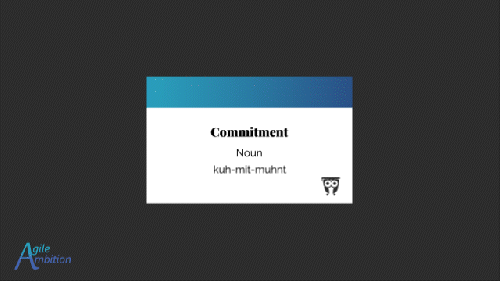Commitment in Scrum: Shared Ownership

Contrary to popular belief, commitment isn’t about doing what you said. It’s about working as a team instead of a group of individuals.
What is Commitment
Commitment is one of the five core scrum values. The other four are focus, openness, respect, and courage.
The scrum guide has this to say:
“The Scrum Team commits to achieving its goals and to supporting each other. ”
- Scrum Guide
Oxford’s English dictionary defines commitment as: “the state or quality of being dedicated to a cause, activity, etc.”

Knowing the opposite of a word helps me soak in its meaning. Here are some words that are antonyms for commitment:
- Indifference
- Unconcern
- Neglect
- Inconstancy
- Unreliability
- Disloyalty
- Irresponsibility
- Inattentiveness
- Negligence
- Defeatism
- Resignation
- Passivity
- Apathetic
- Uninterested
- Uncommitted
- Irresolute
- Indecisiveness
- Wavering
- Vacillation
- Faithlessness
Commitment is Not a Guarantee
It deserves special consideration to point out that commitment isn’t doing what you said you’d do. This definition is a common misunderstanding of the word. If you’re looking for a word with that meaning, integrity might be a better fit.
“Integrity is doing what you said you would do, when you said you would do it and how you said you would do it.”
- Byrd Baggett
A common misconception has popped up that the Sprint Backlog is a commitment that the Scrum Team must kill themselves to accomplish. This unhealthy interpretation of the Scrum Guide leads to a culture of blame.
Command and control leadership likes to throw around the term Sprint Commitment though I can find no original reference to this term in any version of the Scrum Guide. In 2011, the Scrum Guide added some clarifying language to stamp out this toxic misconception.
“Selecting how much can be completed within a Sprint may be challenging. However, the more the Developers know about their past performance, their upcoming capacity, and their Definition of Done, the more confident they will be in their Sprint forecasts.”
- Scrum Guide
In the Scrum framework, commitment is not about guaranteeing final results but ensuring that team members are fully invested in achieving their Sprint Goals. It is about promoting open communication, fostering trust, and encouraging collaboration. This commitment involves active participation in team meetings, sharing feedback, and helping others when needed. Ultimately, the commitment is to individuals and interactions, which creates a culture where high-performance teams can thrive.
Scrum Value of Commitment
Before coming across a one-panel comic involving a fishing boat that succinctly demonstrated the power of commitment, it was hard to wrap my head around this value. In the cartoon, one guy is frantically bailing water rushing in from a hole on his side of the boat. The guy on the other side of the vessel is sitting back, relaxed, thinking, “Man, I’m glad that hole isn’t on my side of the boat.” I love absurdity, and this cartoon helped me have the paradigm shift required to understand commitment.
Imagine your Scrum Team racing to the lake’s other side in a canoe. Each member of your canoe team must participate and give their all for you to have any chance of winning the race. The impact will be immediately noticeable if someone on the canoe team breaks an arm. If all the team members on the right side decided to stop rowing, the canoe would begin to go in circles. Eventually, the left side is going to give up entirely.
If one person has to take a break or deal with an emergency, the rest of the members will have to work harder to pick up the slack, which is only sustainable for short periods. For short periods, your canoe team may pick up the slack for one team member focused on learning a new skill or technique that might benefit the entire team. After all, having a crew of athletic, strong-armed people skilled in rowing is in everyone’s best interest.

Commitment is a critical element in the Scrum framework because if the team members are not all paddling toward the same destination, they will not get anywhere. One uncommitted team member can significantly reduce the odds of success, making it essential for all team members to be fully dedicated to their responsibilities and contributions.
The Scrum values foster a culture of collaboration and continuous learning that helps enable and maintain commitment.
The Benefits of Commitment in Scrum
Commitment in Scrum teams helps to enable six key characteristics of high-performing teams.
Continuous Learning
Scrum teams are committed to continuous learning because strengthening the skills of one team member helps the overall team become stronger. What one member learns, they will naturally share through collaboration.
When everyone is committed to paddling together and reaching the other side of the lake, they all benefit from the journey. The rest of the team can take on the slack when one person stops paddling to learn a new technique. When they return, they bring new knowledge and skills that help the entire team. Team members are encouraged to take time to develop their skills, not because they will get better, but because it will improve the skills of the overall team.
Just as a canoe team must work together to navigate the waters, a Scrum team must work together to navigate the complex software development process. And just as a canoe team benefits from the knowledge and skills of all its members, a Scrum team benefits from the commitment and continuous learning of each team member.
Collaboration
Picture it: you’re in a canoe with your buddies when suddenly, out of nowhere, a waterfall appears in the distance. Suddenly you realize - you need to get out of the water to ensure your safety. You need all hands on deck (or, should I say, all paddles in the water) to accomplish this crucial feat.

That’s where collaboration comes in. The team needs to quickly maneuver the canoe to a bank where they can safely exit. By working together and committing to the team goal, you can accomplish something that would be impossible alone. Each person has unique strengths and skills; by bringing them all together, you create a powerful force that can tackle even the toughest challenges.
Quality
No one wants to paddle in circles or bail out water all day. The whole team goes down if a team member randomly decides to drill a hole in the bottom of the canoe.
It’s unlikely that your canoe buddies will sit by and let you finish drilling that hole.
When you work independently, you’re less concerned about other people’s work quality. But Scrum Teams have a shared Sprint Goal. No one wants to be sitting in the Sprint Review, in front of all of our stakeholders, demoing a new feature when a bug suddenly pops up. It’s in everyone’s best interest to ensure quality, and when you know everyone is watching it, it encourages you to pay extra attention to it as well.
Productivity
If you’re in a canoe race with your teammates, you don’t want to be the one to let the team down by slacking off. When everyone commits to working together toward the same goal, we’re all accountable to each other. It’s like a friendly form of peer pressure that helps us be more productive.

The same concept carries through to a Scrum Team. When we all commit to working together toward the same goal, we become each other’s supporters and motivators. We encourage each other to be productive and do our best because our success depends on everyone’s effort.
Risk Management
Imagine a scenario where a deadly iceberg appears in the middle of the lake. If everyone is in separate boats, you may only be concerned about your maneuvering around said iceberg. If this iceberg poses no threat to you, you may ignore it entirely. Depending on your relationship with others in the water, you may choose not to mention the iceberg and just let them fend for themselves.
If everyone is in the same canoe, you can’t ignore the iceberg. To survive, everyone must be aware of the impediment and work together to determine how to resolve it.

The same concept applies to a Scrum Team. To meet the Sprint Goal, they often can’t afford to turn a blind eye to impediments. It’s in the team’s best interest to draw attention to things that put their success at risk and figure out how to resolve them.
That’s how commitment helps with risk management; it keeps us all alert and ready to tackle obstacles as a team.
Innovation
In a canoeing team, members who possess specialized knowledge to enhance their paddling efficiency are inclined to share their insights with their fellow paddlers. For instance, a member with an engineering background may propose a new paddle design. At the same time, another with expertise in physics can enlighten the team on the optimal weight distribution in the canoe. This knowledge exchange occurs because the team shares the common objective of crossing the lake, and each member’s contribution is essential to achieve a breakthrough in the team’s approach. No one knows which idea might unlock a new way to paddle that revolutionizes the sport.
Discover Better Ways of Working
In a Scrum Team, when faced with resolving an issue or enhancing their processes, the goal is to maximize input to enable effective decision-making. This maximization entails generating diverse knowledge and options, increasing the likelihood of identifying optimal solutions. Individuals are more inclined to contribute their insights and ideas when the team is collectively dedicated to the process and committed to achieving its objectives.
How Can Each Scrum Role Exemplify Commitment?
Product Owner
Continuous Learning
The Product Owner is a critical member of the Scrum team, and their commitment is essential to the team’s success. By learning about new prioritization methods, negotiation skills, and becoming more familiar with the product, the Product Owner can help the team deliver better results.

For example, suppose the Product Owner is more familiar with the product. In that case, they can provide more detailed and accurate requirements to the development team, which can help them work more efficiently and reduce rework. Additionally, if the Product Owner has strong negotiation skills, they can better represent the team’s interests in discussions with stakeholders, resulting in a better outcome for everyone.
Furthermore, the Product Owner’s commitment to learning new skills and approaches can help keep the team aligned and moving forward. By continuously improving their knowledge and skills, the Product Owner can better prioritize work, identify and manage risks, and keep the team focused on the most important goals. These advanced skills ultimately lead to a more productive, efficient, and successful Scrum team.
Dual-Commitment
The Product Owner plays a crucial role in the Scrum Team’s success, but it can be a delicate balancing act. On the one hand, they need to be committed to the Scrum framework and the Sprint Goals, while on the other hand, they need to represent the stakeholders’ interests.
To walk this fine line, the Product Owner can leverage their commitment to the team and the Scrum framework by constantly seeking input from both parties and striving for compromise. By continuously learning and improving their skills, such as negotiation and prioritization, they can make informed decisions that balance the needs of both the stakeholders and the team.
The Product Owner should also be transparent about the constraints and limitations of the team and communicate any challenges or roadblocks to the stakeholders. This way, they can manage the stakeholders’ expectations while maintaining the integrity of the Sprint Goals and the Scrum process.
By being committed to the success of the team and the Scrum process, the Product Owner can maintain a healthy balance between the stakeholders and the team, avoiding the pitfalls of providing too much cover for the team or saying yes to everything stakeholders ask for which would ultimately set the team up for failure due to lack of unlimited capacity.
Scrum Master
Enforcing the Timebox
Enforcing the timebox is an example of a Scrum Master exemplifying commitment because it shows dedication to ensuring that the team follows the agreed-upon process and strives to achieve the Sprint Goal. By enforcing the timebox, the Scrum Master helps the team stay focused and productive and maximizes the time available to complete Product Backlog Items.

Holding the team to the established time for Sprint events like Sprint Planning can be challenging. Team members may be tempted to work outside the timebox to finish discussions or accomplish agenda items.
When the Scrum Master demonstrates a commitment to the process by enforcing the timebox, it can build trust within the team and with stakeholders. They can see that the team is dedicated to maximizing the value they can deliver.
Commit to Organizational Change
A Scrum Master exemplifies commitment by insisting that impediments be fixed instead of ignored or worked around. By ignoring or working around obstacles, team members can continue their tasks in the short term. Still, this approach ultimately jeopardizes the team’s ability to deliver the best product in future Sprints.
Insisting that the organization fixes impediments requires a willingness to identify and confront issues as they arise rather than avoiding or delaying them. It also requires a commitment to ongoing improvement and a willingness to adapt to changing circumstances to maintain progress toward the team’s goals.
If you’re constantly working around issues, it can be a sign of complacency or a lack of willingness to put in the effort required to find a more permanent solution.

A Boy Scout rules state: Leave the campground cleaner than you found it. I always think about this rule when it comes to resolving impediments.
The idea behind this rule is that by leaving the campsite cleaner than when you arrived, you are not only being respectful to the natural environment but also helping preserve it for future generations. It can also instill a sense of stewardship and responsibility for the environment in individuals, which can positively impact their behavior in other areas of life.
When Scrum Masters take ownership of the impediments the Scrum Team cannot solve and work to resolve them, they demonstrate their commitment to the Scrum Team and their desire to create a positive impact. This commitment can create a culture of continuous improvement and innovation, where the team is constantly striving to make the process better than they found it.
Continuous Learning
By pursuing ongoing education and training in Scrum and Agile methodologies, a Scrum Master can deepen their understanding of the framework and gain new skills and knowledge to support their team better. This pursuit of knowledge shows a commitment to the Scrum process and a willingness to improve their abilities continuously.
When a Scrum Master stays up-to-date with industry trends and best practices, they can bring fresh perspectives and innovative ideas to help their team experiment with different processes and techniques. This experimentation can ultimately lead to better outcomes, greater productivity, and increased job satisfaction for everyone involved.
Developer
No Super Chickens
So, you might have heard about this phenomenon called “super chickens” - basically, it’s when we put together a group of high-performing individuals. But instead of collaborating and lifting each other up, they end up pecking each other to death in a cutthroat competition for dominance. Not the most productive way to work, right?
In the same vein, a Scrum team that doesn’t uphold the principle of commitment and instead allows for a bunch of super chickens to run rampant is just asking for trouble. Sure, they might all be highly skilled and talented individuals, but they won’t get very far if they can’t work together and commit to a shared goal.
Embracing collaboration as opposed to competing against your team members will enable the team to see more success. When everyone is committed to the same goal and working together, the sky’s the limit - much higher than a chicken can go.
Fixing Root Cause
Let’s say I have this friend (this definitely is not something I’ve done myself); we’ll call her Duct Tape Deb. Deb always finds innovative ways to hold her car together with that trusty silver tape. Once, she clipped a deer which resulted in the detachment of her side mirror from her vehicle.
Instead of taking it to the mechanic, she grabbed her roll of duct tape and artfully yet temporarily reattached the mirror. And you know what? It held up for a while until the tape got old and brittle, and the mirror inevitably fell off.
But here’s the thing: Duct Tape Deb’s approach to car maintenance isn’t too different from how some developers deal with bugs. They slap on a quick fix - maybe some extra code or a band-aid patch - and call it good. But just like that mirror eventually fell off, those quick fixes will only last so long. The root cause of the bug is still there, waiting to rear its ugly head again.
It takes a dedicated team to dig into the root cause, fix it properly, and ensure it stays fixed. This dedication exemplifies commitment as it shows a willingness to improve the situation of the entire team.
Works Consulted
- There’s Value in the Scrum Values
- Updates to the Scrum Guide: The 5 Scrum values take center stage
- Podcast Ep. 27: Deep Dive on Scrum Values with Sam Falco
- Understanding Scrum Values: Commitment
- Scrum values through the eyes of an Agile team
- Commitment vs. Forecast: A Subtle But Important Change to Scrum
- Collaboration: “The Canoe Theory”
TLDR
It’s important to remember that we’re all in the same boat. If the ship sinks, we all drown.
Commitment is about shared ownership and ensuring we hit our team goals. We agree to processes and plans as a team and follow through because the team has decided that’s the best approach, not because authority commanded us to do so.
All for one, and one for all.
Share
Table Of Contents
Buy Me a Coffee
Are you gaining value and insights from Agile Ambition? If you love what you're learning and want to see more, here's a simple way to show your support. Click the "Buy Me a Coffee" button to make a small donation. Each coffee you buy fuels our journey to discover better ways of working by unpuzzling Agile, one piece at a time.
Buy Me a CoffeeRelated Posts
Quick Links
Legal Stuff

